Classical guitar Finished FP on body.
-
Dave Bagwill
- Posts: 5951
- Joined: Tue Dec 13, 2011 7:44 pm
-
John Parchem
- Posts: 2749
- Joined: Fri Dec 23, 2011 8:33 pm
- Location: Seattle
- Contact:
Re: Starting # 11 a Hauser\Tored\Jeff Elliott Guitar
I am making good progress on the top. The bracing pattern I am using is a modified Hauser 43 plan that I learned in Jeffrey Elliott top voicing class. The interesting thing about this pattern is that it uses open transvers braces to open up the top. To avoid cracking I am gluing 1mm think straps of wood to bridge the openings in the transverse braces. The middle fan brace is 6mm tall the next outside braces are 5mm then 4 mm and the outside braces are 3 mm tall. Not in the picture there will be two 3 mm fan sixed braces in the upper bout to help against cracks and Jeffrey Elliott thought his guitars sounded better with it on.
I used a plane to put close to a 25 ft radius on all of the lower fan braces. I used to use a dish but it is so easy to sand an angle on the bottom that I now use a plane and use the dish to check the fit. Using a block plane I sort of established a planning pattern that resulted in close to the correct radius. I glued some cut off from my sound board patch to my vise and used it to gauge the correct depth to provide relief for the sound board patch and on the outer braces the strap underneath the transverse brace opening.
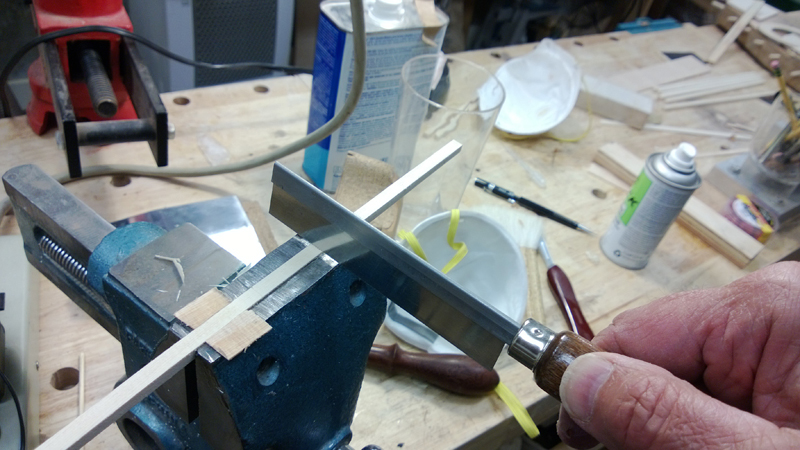
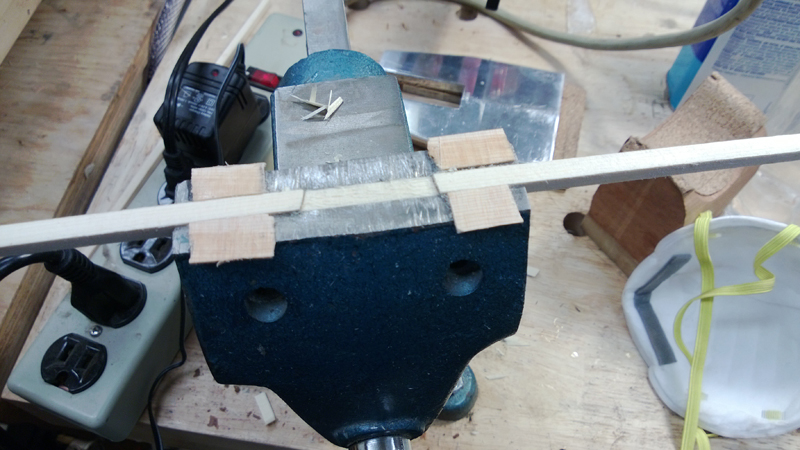
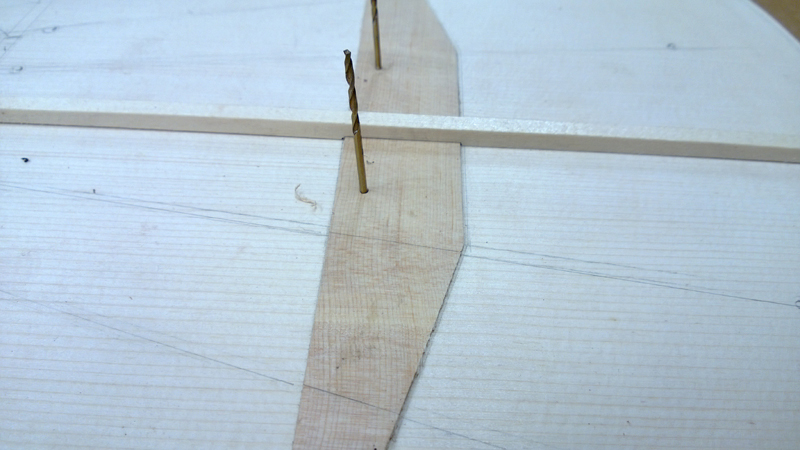
I used the same technique for the transverse brace to make small rabbets for the strap that will bridge the transverse brace opening.
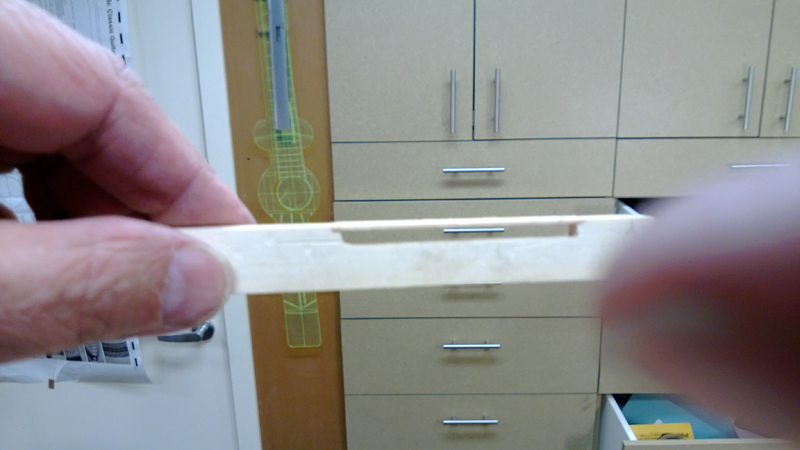
For each of the open transverse braces I used the transverse brace with cuts straps to properly fix the location of the strap. I clamped the brace in the proper location, setting the location for the strap and carefully taped down the strap. I was able to use the tape as a hinge to fold back the strap put glue on it and move it back in to the correct location.
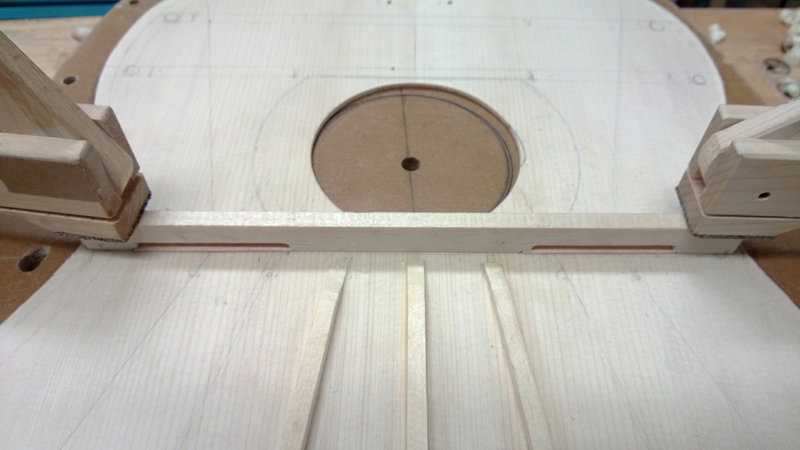
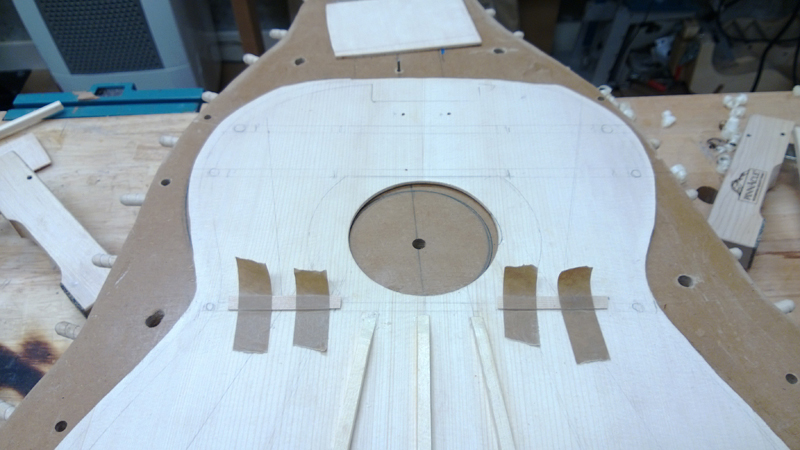
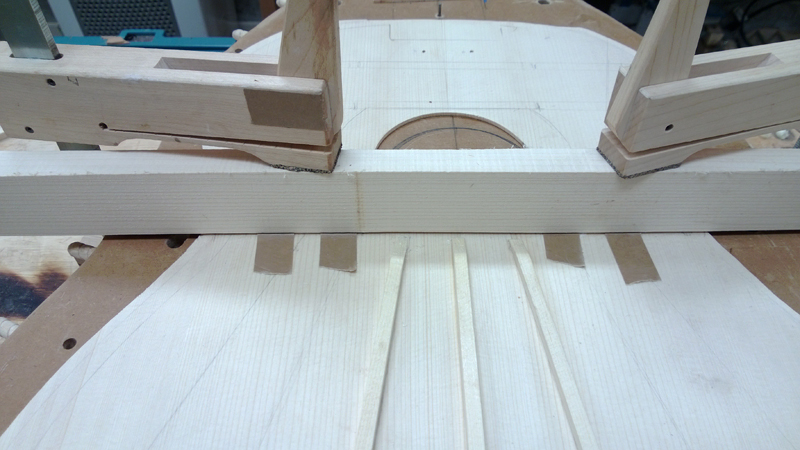
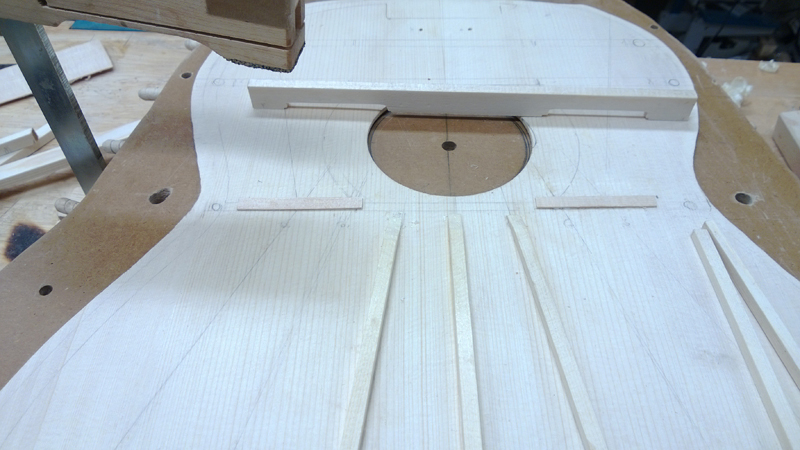
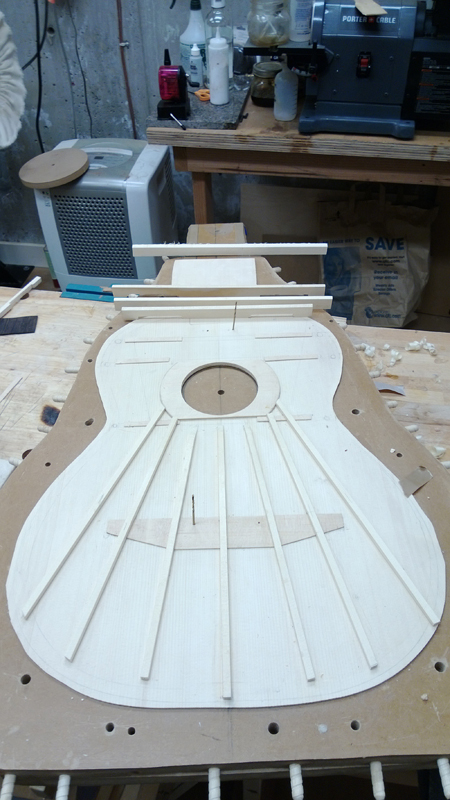
I used my homemade vacuum box to glue the fitted fan braces down.
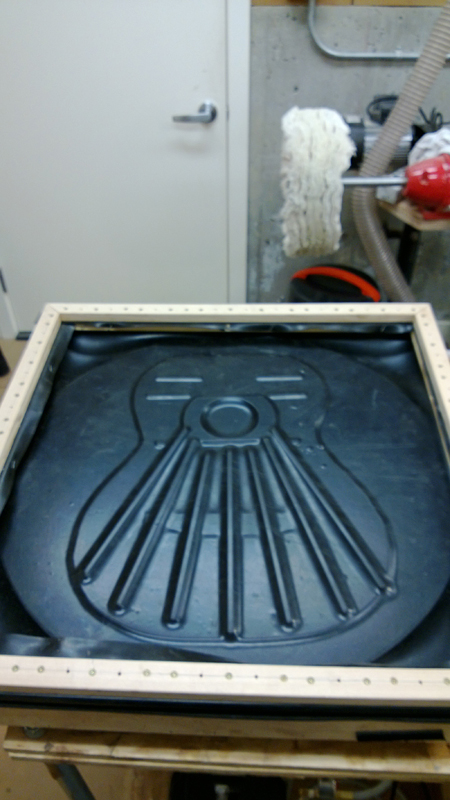
I used a plane to put close to a 25 ft radius on all of the lower fan braces. I used to use a dish but it is so easy to sand an angle on the bottom that I now use a plane and use the dish to check the fit. Using a block plane I sort of established a planning pattern that resulted in close to the correct radius. I glued some cut off from my sound board patch to my vise and used it to gauge the correct depth to provide relief for the sound board patch and on the outer braces the strap underneath the transverse brace opening.



I used the same technique for the transverse brace to make small rabbets for the strap that will bridge the transverse brace opening.

For each of the open transverse braces I used the transverse brace with cuts straps to properly fix the location of the strap. I clamped the brace in the proper location, setting the location for the strap and carefully taped down the strap. I was able to use the tape as a hinge to fold back the strap put glue on it and move it back in to the correct location.





I used my homemade vacuum box to glue the fitted fan braces down.

-
Dave Bagwill
- Posts: 5951
- Joined: Tue Dec 13, 2011 7:44 pm
Re: Starting # 11 a Hauser\Tored\Jeff Elliott Guitar
This is an interesting thread, thanks.
Question: the theory of the x-brace is that it allows for the rocking motion of the bridge, side-to-side and forward-and-back. The theory of the ladder brace is that it provides for a strong fundamental, but loses the overtones and can make for shrill trebles; when done well, of course, it sounds just fine if that is the sound one is going for.
The classic fan-braces look like something in-between: nothing ladderlike, nothing x-like, exactly. My question is why the x-brace, with a properly tuned assembly, would not work for classical guitars as well. Or vice versa - fan frets for flattop guitars.
Question: the theory of the x-brace is that it allows for the rocking motion of the bridge, side-to-side and forward-and-back. The theory of the ladder brace is that it provides for a strong fundamental, but loses the overtones and can make for shrill trebles; when done well, of course, it sounds just fine if that is the sound one is going for.
The classic fan-braces look like something in-between: nothing ladderlike, nothing x-like, exactly. My question is why the x-brace, with a properly tuned assembly, would not work for classical guitars as well. Or vice versa - fan frets for flattop guitars.
-Under permanent construction
Re: Starting # 11 a Hauser\Tored\Jeff Elliott Guitar
Steve Klien had an article in (I think Acoustic Guitar Mag.) --- The essence was, braces are simply a structural element and placement and design had little to do with sound reproduction -- lighter the better -- Kaman agreed -- Ovation steel string guitars have fan bracing. Kaman used acoustic and vibration testing equipment designed to test helicopter components. Scientists that trashed Michael Kasha's designs said the same thing --- and don't forget there are some prized guitars that merely have a couple of ladder braces --- go figure?
ken cierp
http://www.kennethmichaelguitars.com/
Store Front
http://www.cncguitarproducts.com/
KMG Guitar Kit Information
http://www.kennethmichaelguitars.com/ki ... ckage.html
http://www.kennethmichaelguitars.com/
Store Front
http://www.cncguitarproducts.com/
KMG Guitar Kit Information
http://www.kennethmichaelguitars.com/ki ... ckage.html
-
John Parchem
- Posts: 2749
- Joined: Fri Dec 23, 2011 8:33 pm
- Location: Seattle
- Contact:
Re: Starting # 11 a Hauser\Tored\Jeff Elliott Guitar
Classical guitars have half the string load of a SS so they do not need the very effective X brace. But with only half of the load they need to make the most out of the load that they have, so the very light fans work well. Long ago I think Martin did make some nylon string guitars with x-braces. From what I remember reading they did sound that good. The fans do not carry much of the load as the huge transverse braces carry most of the load. Classical guitars strung up with steel strings tend to fold up on themselves in very little time.deadedith wrote:This is an interesting thread, thanks.
Question: the theory of the x-brace is that it allows for the rocking motion of the bridge, side-to-side and forward-and-back. The theory of the ladder brace is that it provides for a strong fundamental, but loses the overtones and can make for shrill trebles; when done well, of course, it sounds just fine if that is the sound one is going for.
The classic fan-braces look like something in-between: nothing ladderlike, nothing x-like, exactly. My question is why the x-brace, with a properly tuned assembly, would not work for classical guitars as well. Or vice versa - fan frets for flattop guitars.
Hauser and Torres guitars have a pretty defined sound, luthiers have tweaked the bracing patterns trying to get more concert volume while maintaining the sound. There are newer designs that go away from the nuanced and responsive sound that a good guitarist can get from this style of classical guitar for a cleaner more powerful sound, lattice braced, carbon fiber tops ... This fan braced design is meant to capture a fairly defined sound, while still providing concert volume.
-
Dave Bagwill
- Posts: 5951
- Joined: Tue Dec 13, 2011 7:44 pm
Re: Starting # 11 a Hauser\Tored\Jeff Elliott Guitar
I'm attaching a pic of the bracing on an old Harmony Sovereign - those guitars (the flattops) can sound wonderful, amazingly, looking at the amount and size of the bracing, and they were all ladder braced until sometime in the 70's.
Not trying to hijack the thread John! - it's just that the picture of your fan braces brought some questions to mind.
How to account for a great sound with the amount and style of those braces is beyond me.
Not trying to hijack the thread John! - it's just that the picture of your fan braces brought some questions to mind.
How to account for a great sound with the amount and style of those braces is beyond me.
- Attachments
-
- harmtop.jpg (66.47 KiB) Viewed 1564 times
-Under permanent construction
-
John Parchem
- Posts: 2749
- Joined: Fri Dec 23, 2011 8:33 pm
- Location: Seattle
- Contact:
Re: Starting # 11 a Hauser\Tored\Jeff Elliott Guitar
Dave,
Wonderful is subjective, how would the harmony sound in a concert hall unamplified next to a martin dread ... Also a great sounding electric is a horrifying sounding classical. I think there are unlimited styles of guitar that can sound great in the right environment and with the right music. The bracing patterns matter when you want as close to a particular sound as possible. The fan pattern grew out of a desire for no bracing but the necessity for some structure.
Wonderful is subjective, how would the harmony sound in a concert hall unamplified next to a martin dread ... Also a great sounding electric is a horrifying sounding classical. I think there are unlimited styles of guitar that can sound great in the right environment and with the right music. The bracing patterns matter when you want as close to a particular sound as possible. The fan pattern grew out of a desire for no bracing but the necessity for some structure.
